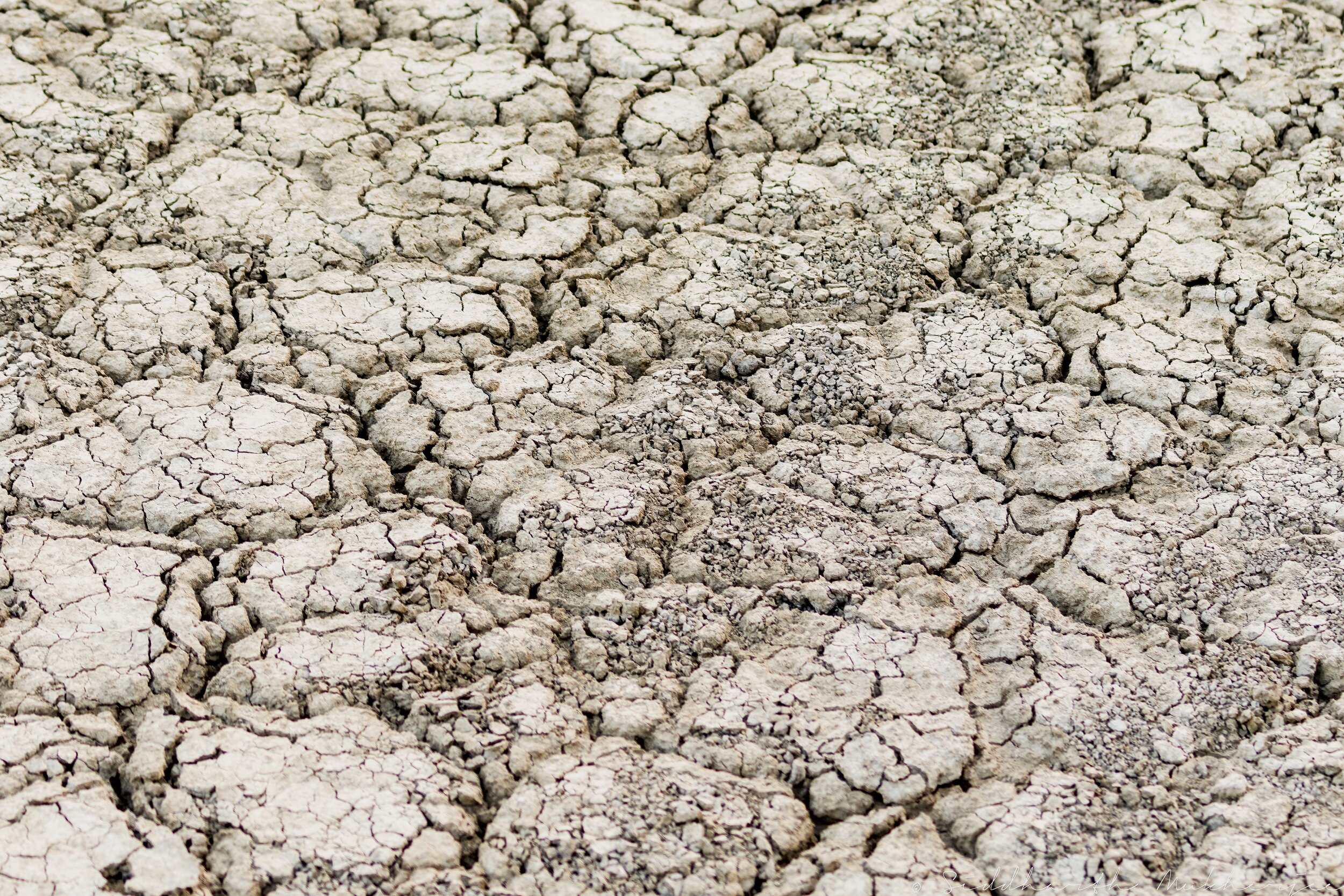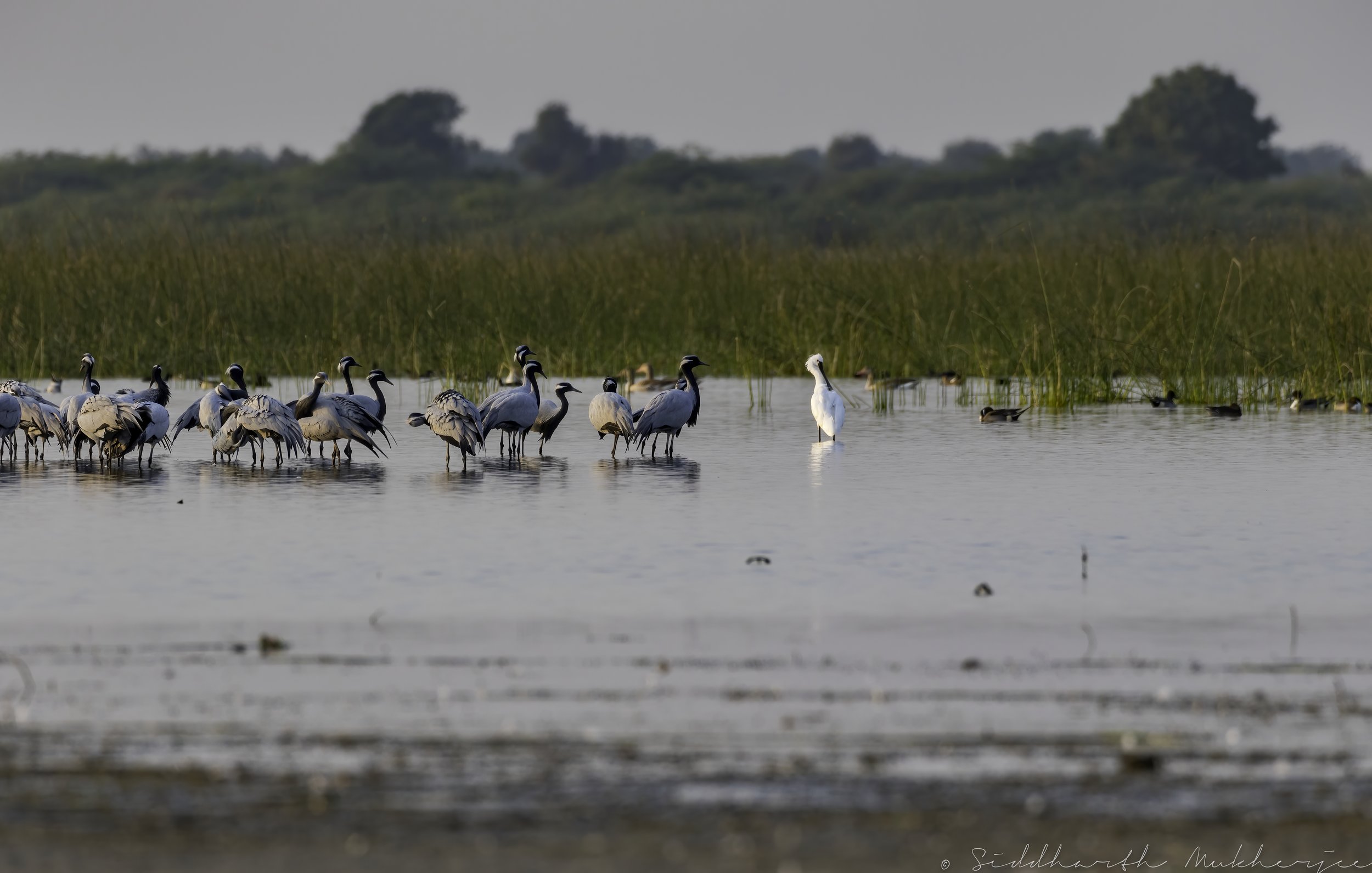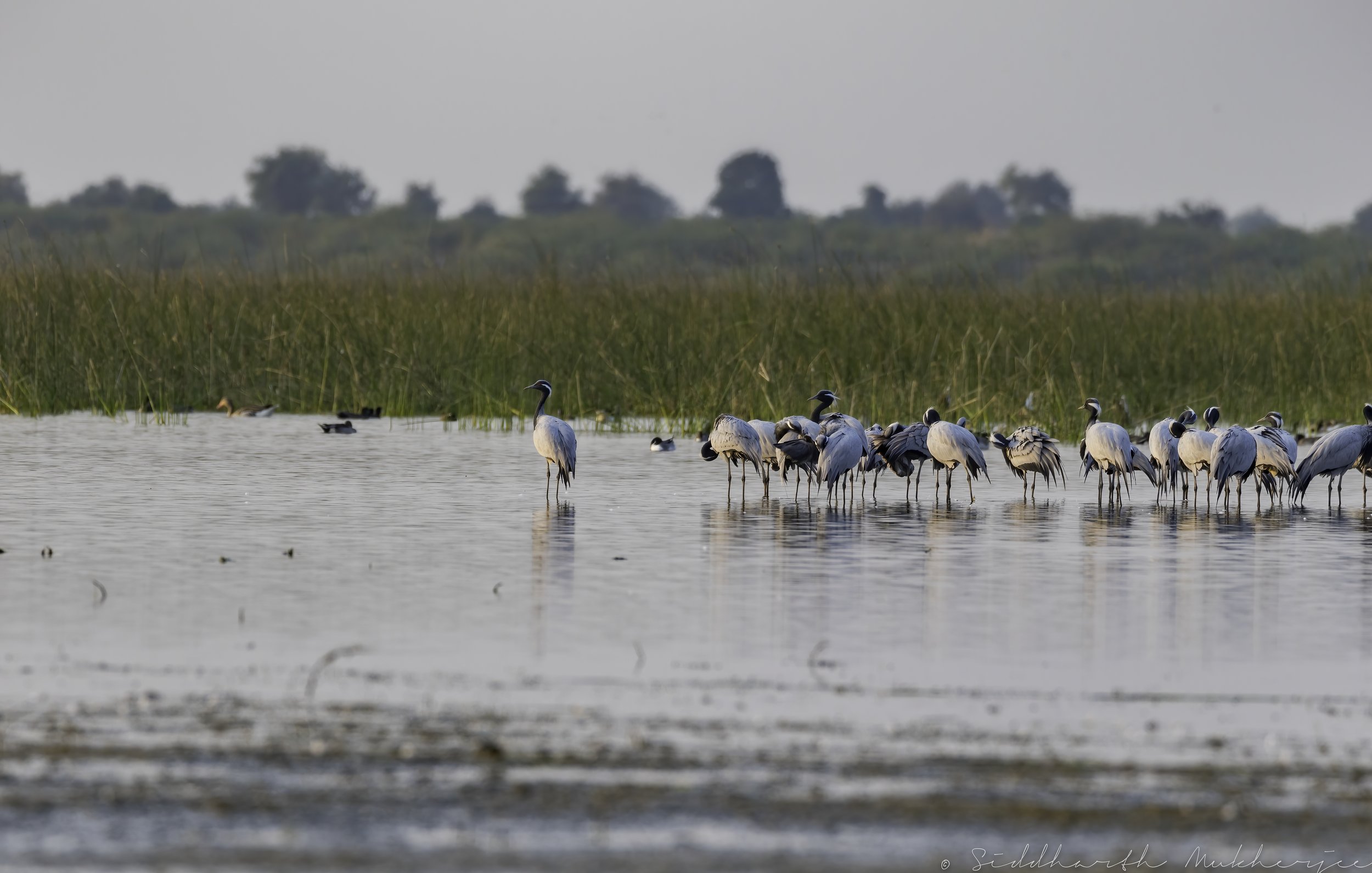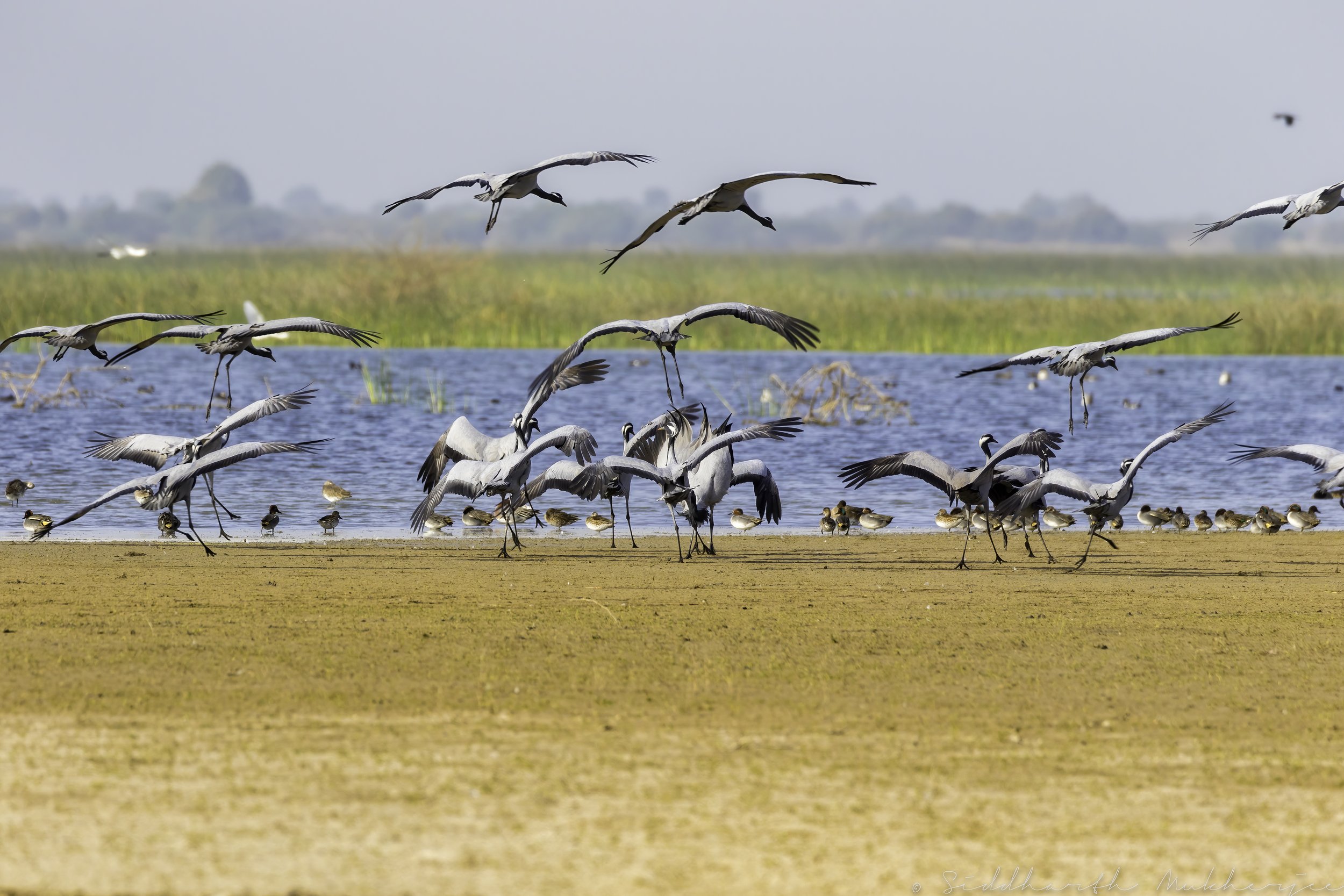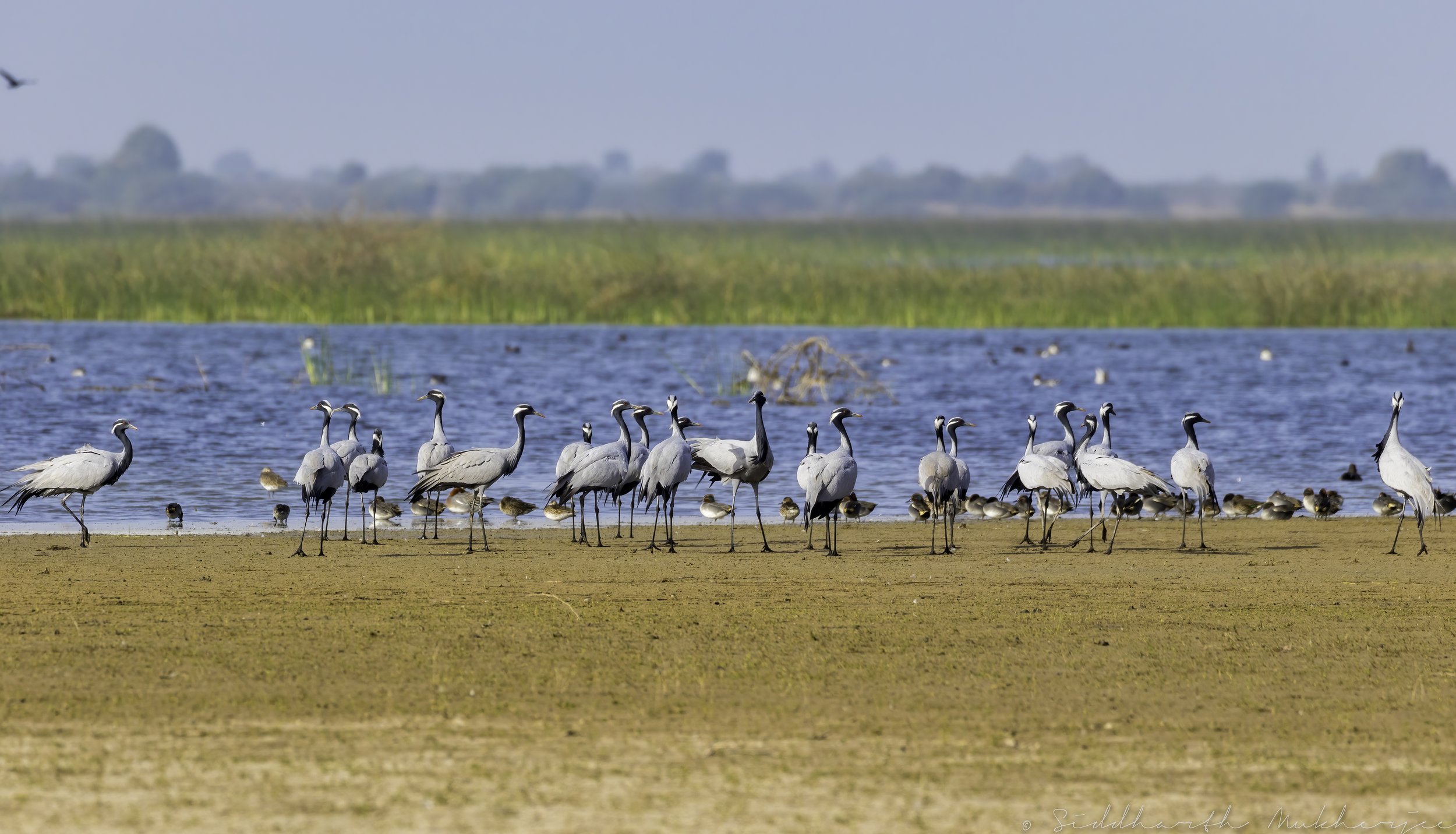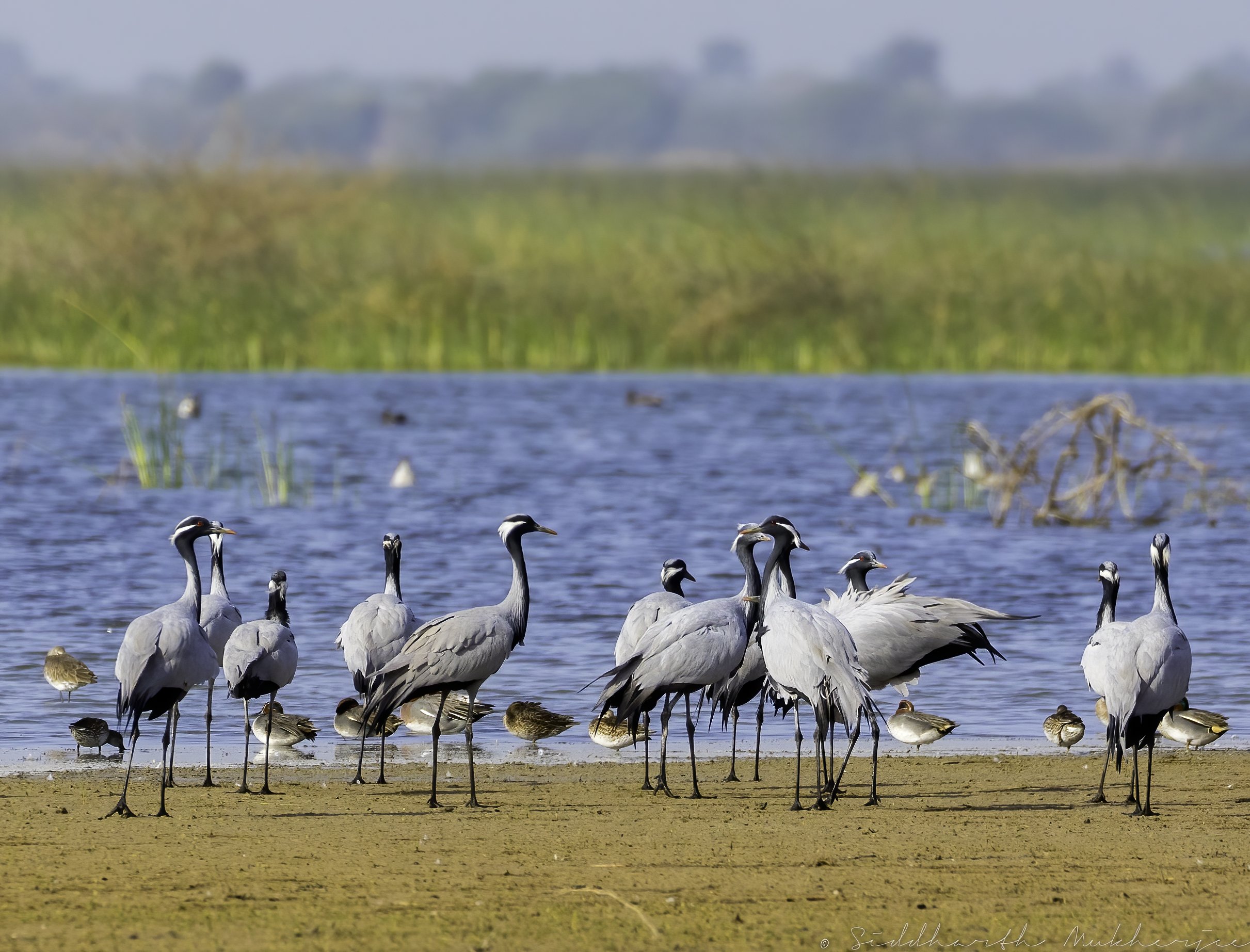Demoiselle Crane
Grus virgo
Little Rann of Kutch
Today is about the smallest species of crane, the Demoiselle Crane (Grus virgo). This crane is a species found in central Eurosiberia, ranging from the Black Sea to Mongolia and North Eastern China with a small breeding population in Turkey. These cranes are migratory and birds from western Eurasia will spend the winter in Africa while the birds from Asia, Mongolia and China will spend the winter in the Indian subcontinent.
The Demoiselle Crane is symbolically significant in the culture of India, where it is known as Koonj or Kurjaa.
Published on the NatGeo & Wild Bird Revolution blog on Flocks on November 09, 2018
Cranes are a family, the Gruidae, of large, long-legged, and long-necked birds in the group Gruiformes. The 15 species of cranes are placed in three genera, Antigone, Balearica, and Grus. Unlike the similar-looking but unrelated herons, cranes fly with necks outstretched, not pulled back. Cranes live on most continents, with the exception of Antarctica and South America.
Cranes are opportunistic feeders that change their diets according to the season and their own nutrient requirements. They eat a range of items from small rodents, eggs of birds, fish, amphibians, and insects to grain and berries. They construct platform nests in shallow water, and typically lay two eggs at a time. Both parents help to rear the young, which remain with them until the next breeding season.
Some species and populations of cranes migrate over long distances; others do not migrate at all. Cranes are solitary during the breeding season, occurring in pairs, but during the non-breeding season, most species are gregarious, forming large flocks where their numbers are sufficient.
Cranes are very large birds, often considered the world's tallest flying birds. They range in size from the demoiselle crane featured here, which measures 90 cm in length, to the Sarus Crane, which can be up to 176 cm, although the heaviest is the red-crowned crane, which can weigh 12 kg prior to migrating. They are long-legged and long-necked birds with streamlined bodies and large, rounded wings. The males and females do not vary in external appearance, but males tend to be slightly larger than females.
Most species of cranes have been affected by human activities and are at the least classified as threatened, if not Critically Endangered. Read about the largest crane I have also had the good fortune to observe - the Vulnerable Red-crowned Crane, the Tanchōzuru.
The plumage of cranes varies by habitat. Species inhabiting vast, open wetlands tend to have more white in their plumage than do species that inhabit smaller wetlands or forested habitats, which tend to be more grey. These white species are also generally larger. The smaller size and colour of the forest species is thought to help them maintain a less conspicuous profile while nesting; two of these species (the common and sandhill cranes) also daub their feathers with mud which some observers suspect helps them to hide while nesting.
So first a bit about the habitat where I observed these magnificent birds - the Little Rann of Kutch.
Little Rann of Kutch
The Rann of Kutch (alternately spelled as Kuchchh) is a large area of salt marshes that spans the border between India and Pakistan. It is located mostly in the Kutch district of the Indian state of Gujarat, with a minor portion extending into the Sindh province of Pakistan. It is divided into the Great Rann and Little Rann.
The Rann of Kutch covers around 26,000 km² (10,000 square miles). The Great Rann of Kutch is the larger portion of the Rann and it extends east and west, with the Thar Desert to the north and the low hills of Kutch to the south. The Indus River Delta lies to the west in southern Pakistan. The Little Rann of Kutch lies southeast of the Great Rann, and extends southwards to the Gulf of Kutch. Many rivers originating in Rajasthan and Gujarat flow into the Rann of Kutch, including the Luni, Bhuki, Bharud, Nara, Kharod, Banas, Saraswati, Rupen, Bambhan, and Machchhu. Kori Creek and Sir Creek, tidal creeks which are part of the Indus River Delta, are located at the western end of the Great Rann.
The surface is generally flat and very close to sea level, and most of the Rann floods annually during the monsoon season. There are areas of sandy higher ground, known as bets or medaks, which lie two to three metres above flood level. Read more about the Khadir Bet island where I talk about Dholavira later. Trees and shrubs grow on the bets, and they provide refuges for wildlife during the annual floods. The climate of the ecoregion is subtropical. Temperatures average 44 °C during the hot summer months, and can reach highs of 50 °C and during the winter the temperature can drop to or below freezing.
Rainfall is highly seasonal with the Rann being dry for most of the year, and rainfall is concentrated in the June to September monsoon season. During the monsoon season, local rainfall and river runoff flood much of the Rann to a depth of 0.5 metres. The waters evaporate during the long dry season, leaving the Rann dry again by the start of the next monsoon season.
The Rann of Kutch is the only large flooded grasslands zone in the Indomalayan realm. The area has desert on one side and the sea on the other enables various ecosystems, including mangroves and desert vegetation. Its grassland and deserts are home to forms of wildlife that have adapted to its often harsh conditions. These include endemic and Endangered animal and plant species. The predominant vegetation in the Rann of Kutch is grassland and thorn scrub. Common grass species include Apluda aristata, Cenchrus spp., Pennisetum spp., Cymbopogon spp., Eragrostis spp., and Elionurus spp.
Very unique to this Rann, are the shrubs and wetlands, as well as the colonies of flamingos, which make it one of the rarest sites on earth. Established in 1973, under the Wildlife Protection Act, the WildAss Sanctuary protects the Endangered (Schedule - I) and endemic Indian Wild Ass (Equus Hemionus Khur) popularly known as Khur or Ghudkhur. Trees are rare except on the bets which rise above the flood zone. The non-native tree Prosopis juliflora has become established on the bets, and its seed pods provide year-round food for the Near Threatened Indian Wild Ass. The Little Rann of Kutch Wildlife Sanctuary is a desolate area in western Gujarat, a refuge for the Endangered Indian Wild Ass and one of the few places where the ass survives in the wild. Interestingly, this animal has its only gene pool in the Little Rann. This biogeographical region is a part of Desert, but is unlike the neighbouring sandy desert in Rajasathan or elsewhere in the world.
Read about the Indian Wild Ass here.
Birds found in the Little Rann include the Steppe, Imperial, and short-toed eagles, Houbara bustard, flamingos, pelicans, storks and cranes. You can expect to see large flocks of larks and other dry-land birds such as sand grouse, coursers, plovers, chats, warblers, babblers and shrikes. The best birding is in the winter months from October to March, when quantities of waterfowl gather. This is the time when demoiselle and common cranes, and lesser flamingoes are seen in incredibly large numbers. The wetlands also attract large numbers of waterfowl. During the monsoon when the park is closed, the salt pans flood, and at other times of the year a thin, hard surface layer hides treacherous quicksand.
Covering a staggering 4,950 square kilometres, the Little Rann of Kutch it is one of India’s largest reserves, with a diverse landscape – an impressive mixture of arid, and treacherous, salt flats, desert grassland, scrubland, lakes and marshes. It is home to numerous species of mammals like the Indian Wild Ass, the Nilgai, Indian Wolf, Indian Fox, Desert Fox, Jackal, Striped Hyena, Wild boar, Jungle Cat as well as Chinkara and Blackbuck.
The surrounding areas include Lake Nawa Talao, the village lake of Dasada, the wetlands near Patdi Fort, Viramgam Lake and Surendranagar reservoirs – all of which offer great winter birding opportunities with regular sightings of rose-coloured starlings, green pigeons and Critically Endangered Lesser Florican. Slightly further afield is the Nalsarovar Bird Sanctuary and the famed Sun Temple of Modhera.
Nalsarovar Bird Sanctuary lies 44 kilometres from Dasada and the Little Rann of Kutch National Park. This 105 km² sanctuary comprises a large lake & its surroundings, and is renowned as one of the finest birding sites in West India. As well as the extensive variety of birds seen in large flocks at the lake, and their predators such as marsh harrier and fishing eagle, you can also see numerous passerines in the neighbouring bushes, grasslands and fields. Sarus cranes are also frequently sighted.
The 11th century Sun Temple at Modhera is one of the finest shrines in West India. It was constructed by the Solanki Rajput kings, using the donations of devotees who practiced the ancient tradition of sun worship. The magnificent temple features amazingly detailed carved arches and pillars that rival the temples of Konark and Khajuraho. More about the stunning Modhera Sun Temple later and in the meantime if it piques the interest you can read about the mind boggling Konark Temple here.
The Little Rann of Kutch is located around 100 kilometres north of Ahmedabad on an ancient trading route dating back to early neolithic settlements. It was later inhabited by the Indus Valley civilisation as well as the Maurya and Gupta empires of India. I have written about one of the mega cities from the times of the Indus Valley Civilisation, known locally as Kotada timba - Dholavira. The people of the Indus civilization appear to have settled in the Rann of Kutch around 3500 BCE. The Indus city of Dholavira, the largest Indus site in India, is located here in the Rann of Kutch. Its location is on the Tropic of Cancer and it is one of the five largest Harappan sites and the most prominent site in India possibly indicating that Dholavira's inhabitants were skilled in astronomy.
Many Indologists such as A. S. Gaur and Mani Murali hold the view that the Rann of Kutch was, rather than the salt marsh that it is today, a navigable archipelago at the time of the Indus Civilization. The Indus Civilization was known to have an extensive maritime trade system, so it has been proposed by Gaur et al. that there were perhaps ports in the Rann of Kutch.
Read about the Harappan mega city of Dholavira here.
With that said lets move onto our focus today, the Demoiselle Crane. I had tried my best to crawl and approach these cranes for a closer perspective but they were very skittish and took off at the slightest of noise.
Demoiselle Crane
The demoiselle is 85–100 cm long, 76 cm tall and has a 155–180 cm wingspan. It weighs 2–3 kg. It is the smallest species of crane. The demoiselle crane is slightly smaller than the common crane but has similar plumage. It has a long white neck stripe and the black on the foreneck extends down over the chest in a plume.
It has a loud trumpeting call, higher-pitched than the common crane. Like other cranes it has a dancing display, more balletic than the common crane, with less leaping.
Demoiselle Crane Range & Distribution
Source: International Crane Foundation
The demoiselle was so named by Queen Marie Antoinette, for its delicate and maiden-like appearance.
These cranes thrive in a variety of different environments, including deserts and numerous types of grasslands (flooded, mountain, temperate & tropical grassland) which are often within a few hundred metres of streams or lakes. However, when nesting, they prefer patchy areas of vegetation which is tall enough to conceal them and their nests, yet short enough to allow them look out for predators whilst incubating their eggs.
Demoiselle cranes have to take one of the toughest migrations in the world. In late August through September, they gather in flocks of up to 400 individuals and prepare for their flight to their winter range. During their migratory flight south, demoiselles fly like all cranes, with their head and neck straight forward and their feet and legs straight behind, reaching altitudes of 16,000–26,000 feet. Along their arduous journey they have to cross the Himalayan mountains to get to their over-wintering grounds in India. Many die from fatigue, hunger and predation from golden eagles. Simpler, lower routes are possible, such as crossing the range via the Khyber Pass. However, their presently preferred route has been hard-wired by countless cycles of migration. At their wintering grounds, demoiselles have been observed flocking with common cranes, their combined totals reaching up to 20,000 individuals. Demoiselles maintain separate social groups within the larger flock. In March and April, they begin their long spring journey back to their northern nesting grounds. In Khichan, Rajasthan in India, villagers feed the cranes on their migration and these large congregations have become an annual spectacle.
The demoiselle crane is evaluated as Least Concern on the IUCN Red List of Threatened Species. It is one of the species to which the Agreement on the Conservation of African-Eurasian Migratory Waterbirds (AEWA) applies. But that said there are threats to it including habitat loss, including desertification, changes in agriculture practices, human disturbance, dams and water diversions, and illegal trade leading to hunting, trapping and poisoning.
The demoiselle crane is known as the Koonj /Kurjan in the languages of North India, and figure prominently in the literature, poetry and idiom of the region. Beautiful women are often compared to the koonj because its long and thin shape is considered graceful. Metaphorical references are also often made to the koonj for people who have ventured far from home or undertaken hazardous journeys. The name koonj is derived from the Sanskrit word kraunch, which is a cognate Indo-European term for crane itself. In the ancient story of Valmiki, the composer of the Hindu epic Ramayana, it is claimed that his first verse was inspired by the sight of a hunter kill the male of a pair of demoiselle cranes that were courting. Observing the lovelorn female circling and crying in grief, he cursed the hunter in verse. Since tradition held that all poetry prior to this moment had been revealed rather than created by man, this verse concerning the demoiselle cranes is regarded as the first human-composed meter.
The flying formation of the koonj during migrations also inspired infantry formations in ancient India. The Mahabharata epic describes both warring sides adopting the koonj formation on the second day of the Kurukshetra War.
In Pashto this bird is called (Zaanray), like Urdu where koonj is used for beautiful person the Pashto word Zaanray also used for beautiful person.
‡‡‡‡‡
With that said these are some photos from the time I spent in the Little Rann of Kutch starting with a drive into the Rann as the sun rose behind us. This was one instance when I was able to go to ground and lay prone a few meters away from the birds as they foraged.
Related Posts


